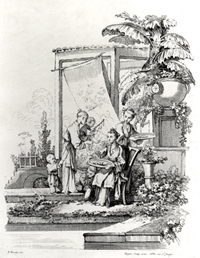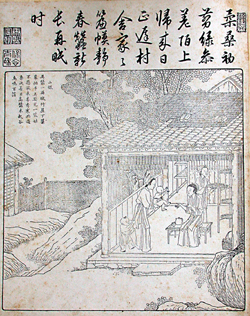|
This elaborate French potpourri holder—one of a pair once owned by Madame de Pompadour—is a key example of European chinoiserie. Its forms and colors are thoroughly French, but the painting on its front can be traced back to Chinese sources.
The history of this image reveals how both Chinese and European artists imitated and re-invented Asian motifs.
From Print to Vase
The painter of this vase, Charles-Nicolas Dodin, probably based his composition on the print illustrated below at left, which was created after designs by the French painter François Boucher.
Boucher's designs were popular throughout Europe in the mid-1700s, especially among porcelain painters and other decorative artists.
|

 |
 |
Seated Woman with Children and Servants, Gabriel Huquier after François Boucher, about 1738–1745
|
 |
 |
From China to Europe
Boucher, in turn, drew his imagery from Chinese woodblock prints such as the one below by Chinese artist Zhu Gui. Zhu's prints depicting the cultivation of rice and silk served as models both for Chinese porcelain painters and for Western makers of chinoiserie.
The setting and the poses of the figures in this print are similar, but not identical, to those in the vase painting it inspired.
|
 |

 |
 |
Silkworms' Second Moulting, Zhu Gui after Jiao Bingzhen, 1696
|
 |
From Painting to Woodblock
Zhu Gui's woodblock prints are themselves adaptations of paintings by another Chinese artist, court painter Jiao Bingzhen. The trail of influence does not end here, however. Jiao's paintings were influenced by Western artistic traditions, particularly by Western conventions of perspective. Jiao probably learned about Western art from Jesuit missionaries in China.
|